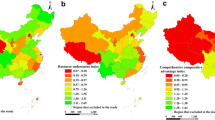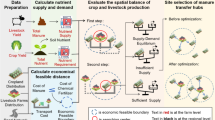Abstract
This study aimed to optimise the layout of pig breeding in the south water network area and guide the transfer of pig production capacity to the areas with large environmental capacity and the main maize-producing areas. Combining with the alarm value of equivalent pig manure load on cultivated land, the comprehensive advantage index of maize and GIS (Geographic Information System), this study analysed the spatial layout planning of the pig northward movement in China. Results showed that the alarm value of equivalent pig manure load on cultivated land in other parts of the study area exceeded 0.40, except in Jilin, Heilongjiang and the Inner Mongolia Autonomous Region. The highest alarm value of equivalent pig manure load on cultivated land value of 1.96 was observed in Fujian Province, followed by Jiangxi (1.09) and Hubei (0.42). A total of 573.996 million excess pig equivalents were present in the study area. In the provinces with potential pig equivalent, Jilin, Heilongjiang and the Inner Mongolia Autonomous Region can carry the potential pig equivalent of 306.270 million. The priority target areas of the pig northward movement were Jilin, Heilongjiang and the Inner Mongolia Autonomous Region according to the comprehensive advantage index of maize. Combining with the spatial analysis method of GIS, the scheme of the pig northward movement was obtained. According to the spatial layout planning of the pig northward movement, Jilin and Heilongjiang carried 15.339 and 135.36 million pig equivalents, respectively, thereby reaching the maximum number of pig equivalents they can carry, whereas the Inner Mongolia Autonomous Region can carry 80.086 million pig equivalents. The results can provide a scientific basis for the spatial layout planning of pig breeding and environmental pollution protection in China.



Similar content being viewed by others
Availability of data and materials
The datasets used and/or analysed during the current study are available from the corresponding author on reasonable request.
References
Chen JI, Chen Q, Trienekens J, Wang HT (2018) Determinants of cooperative pig farmers’ safe production behaviour in China-evidences from perspective of cooperatives’ services. J Integr Agric 17(10):2345–2355
Geng W, Hu L, Cui JY, Bu MD, Zhang BB (2013) Biogas energy potential for livestock manure and gross control of animal feeding in region level of China. Trans Chin Soc Agric Eng 29(1):171–179
Han DM, Jin SQ, Hu Y, Wu TL, Chen YL (2019) Environmental risks and precautions in pig husbandry relocation in China. Chin J Eco-Agric 27(6):951–958
Leng B, Ji X, Zhang W, Tu G (2018) Study on technical efficiency of large-scale pig breeding in north China. Chinese Journal of Agricultural Resources & Regional Planning 39(1):183–187
Li J, Wu GY, Jiang CH, Luo WW, Yang JJ, Guo L (2019) Application of pig manure resource utilization technology in Northeast China. China Biogas 37(3):100–104
Liao Y, Xia QQ, Chen WX, Huang DM, Meng ZL (2017) Empirical study on regional distribution change of pig production and its influencing factors in China. Chin J Anim Sci 53(4):144–149
Liu YZ, Ji YQ, Shao S, Zhong FN, Zhang N, Chen YS (2017) Scale of production, agglomeration and agricultural pollutant treatment: evidence from a survey in China. Ecol Econ 140:30–45
Ministry of Agriculture of the People’s Republic of China (2015) Guidance of the Ministry of Agriculture on promoting the adjustment and optimization of pig breeding layout in southern water network area. [EB/OL]. http://www.moa.gov.cn/govpublic/XMYS/201511/t20151127_4917216.htm.
Ministry of Agriculture of the People’s Republic of China (2017) National plan for the development of pig production (2016–2020). China Agric Inf 1:16–22
Prandini A, Sigolo S, Morlacchini M, Marocco A, Lo Pinto M (2011) High-protein maize in diets for growing pigs. Anim Feed Sci Technol 165:105–110
Shen G, Wang Y, Yuan D (1994) Loading amounts of animal feces and their alarming values and classification grades in shanghai suburbs. Acta Agric Shanghai 10(S1):6–11
State Environmental Protection Administration (2002) Investigation and control countermeasures of pollution situation of livestock and poultry breeding industry in China. China Environmental Science Press, Beijing, pp 14–103
Tan Y, Zhang JY, He QY (2018) Research on the evolution and regional optimization of pig production layout in China. Heilongjiang Anim Sci Vet Med 6:6–10
Wang J, Tian L, Zhang YJ (2011) Analysis on regional distribution change of pig production in China. Chin J Anim Sci 47(10):19–21
Wang C, Chen YS, Han JL, Mo DL, Liu XJ, Liu XH (2019) Mitochondrial DNA diversity and origin of indigenous pigs in south China and their contribution to western modern pig breeds. J Integr Agric 18(10):2338–2350
Wu X, Chen L, Pan HM, Wang JY (2013) Thirty years, the regional distribution of pig breeding in China. Chinese Journal of Animal Science 49(16):7–10
Yan BJ, Yan JJ (2019) Comparative analysis of characterization methods of potential environmental pollution risk from livestock and poultry breeding. Pol J Environ Stud 28(4):2483–2489
Yan B, Shi W, Wang Z, Zhu M, Liu Y (2017) The environmental risk assessment in farmland polluted by livestock and poultry feces in Fujian province based on multi-indices. Acta Sci Circumst 37(3):1146–1152
Yan BJ, Yan JJ, Shi WJ, Li YX (2020) Study on the comprehensive comparative advantages of pig production and development in China based on geographic information system. Clean Tech Environ Policy 22(1):105–117
Yu HK, Wu JZ, Wang YH, Shen C (2018) Analysis on current situation, model and regional distribution of pig breeding industry in China. China Swine Ind 13(1):23–26
Yuan ZW, Pan X, Chen TM, Liu XW, Zhang Y, Jiang SY, Hu S, Zhang L (2018) Evaluating environmental impacts of pig slurry treatment technologies with a life-cycle perspective. J Clean Prod 188:840–850
Zhong Y, Huang Z, Wu L (2017) Identifying critical factors influencing the safety and quality related behaviors of pig farmers in China. Food Control 73:1532–1540
Zhou X, Luo Q, Qu B (2007) Studies on the regional development of live pig in China. Chin J Agric Resour Reg Plann 28(3):41–44
Zhou JJ, Tan Y, Hu HT (2018) The influences of environmental regulations on hog production distribution and industry movement in China. Res Agric Modernization 39(3):440–450
Zhu JC, Zhang ZQ, Fan ZM, Li RH (2014) Biogas potential, cropland load and total amount control of animal manure in China. J Agro-Environ Sci 33(3):435–445
Funding
This research had been partly supported by the National Natural Science Foundation of China under Grant Nos. 41601601, 61501249 and 61971236; the Fujian Provincial Colleges and Universities Supporting Plan for Excellent Talents in the New Century in 2018 under Grant No. 3230412301; the Project funded by China Postdoctoral Science Foundation under Grant No. 2018M632348 and the Natural Science Foundation of Fujian Province under Grant No. 2020J01830.
Author information
Authors and Affiliations
Contributions
All authors contributed to the study conception and design. Material preparation, data collection and analysis were performed by Yanfang Qin, Yaxing Li and Jingjie Yan. The first draft of the manuscript was written by Bojie Yan, and all authors commented on previous versions of the manuscript. All authors read and approved the final manuscript.
Corresponding author
Ethics declarations
Ethics approval and consent to participate
Not applicable
Consent for publication
Not applicable
Competing interests
The authors declare no competing interests.
Additional information
Responsible Editor: Philippe Garrigues
Publisher’s note
Springer Nature remains neutral with regard to jurisdictional claims in published maps and institutional affiliations.
Rights and permissions
About this article
Cite this article
Yan, B., Li, Y., Qin, Y. et al. Spatial layout planning of the pig northward movement based on GIS. Environ Sci Pollut Res 28, 41051–41060 (2021). https://doi.org/10.1007/s11356-021-13357-z
Received:
Accepted:
Published:
Issue Date:
DOI: https://doi.org/10.1007/s11356-021-13357-z




